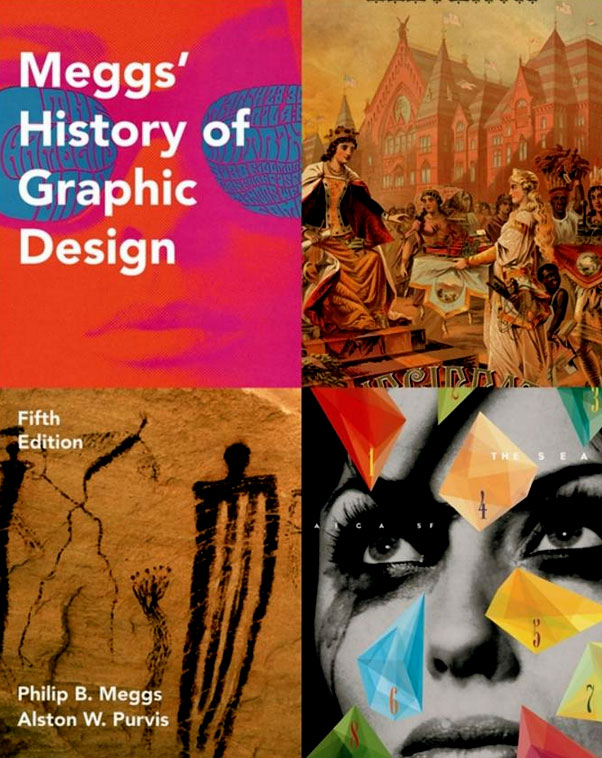Meggs’ History of Graphic Design
There is a German word, Zeitgeist, that does not have an English equivalent. It means the spirit of the times, and refers to the cultural trends and tastes that are characteristic of a given era. The immediacy and ephemeral nature of graphic design, combined with its link with the social, political, and economic life of its culture, enable it to more closely express the Zeitgeist of an epoch than many other forms of human expression. Ivan Chermayeff, a noted designer, has said: the design of history is the history of design.
Since prehistoric times, people have searched for ways to give visual form to ideas and concepts, to store know-ledge in graphic form, and to bring order and clarity to information. Over the course of history, these needs have been filled by various people, including scribes, printers, and artists. It was not until 1922, when the outstanding book designer William Addison Dwiggins coined the term graphic design to describe his activities as an individual who brought structural order and more visual form to printed communications, that an emerging profession received an appropriate name. However, the contemporary graphic designer is heir to a distinguished ancestry. Sumerian scribes who invented writing, Egyptian artisans who combined words and images on papyrus manuscripts, Chinese block printers, medieval illuminators, and fifteenth-century printers and compositors who designed early European books all became part of the rich heritage and history of graphic design. By and large, this is an anonymous tradition, for the social value and aesthetic accomplishments of graphic designers, many of whom have been creative artists of extraordinary intelligence and vision, have not been sufficiently recognized.
History is in large measure a myth, because the historian looks back over the great sprawling network of human struggle and attempts to construct a web of meaning. Oversimplification, ignorance of causes and their effects, and the lack of an objective vantage point are grave risks for the historian. When we attempt to record the accomplishments of the past, we do so from the vantage point of our own time. History becomes a reflection of the needs, sensibilities, and attitudes of the chronicler’s time as surely as it represents the accomplishments of bygone eras. As much as one might strive for objectivity, the limitations of individual knowledge and insights ultimately intrude.
The concept of art for art’s sake, a beautiful object that exists solely for its aesthetic value, did not develop until the nineteenth century.
Before the Industrial Revolution, the beauty of forms and images that people made were linked to their function in human society. The aestnetic qualities of Greek pottery, Egyptian hieroglyphics, and medieval manuscripts were totally integrated with useful values; art and life were unified into a cohesive whole. The din and thunder of the Industrial Revolution turned the world upside down in a process of upheaval and technological progress that continues to accelerate at an ever-quickening pace. By jolting the arts and crafts from their social and economic roles, the machine age created a gulf between people’s material life and their sensory and spiritual needs. Just as voices call for a restoration of humanity’s unity with the natural environment, there is a growing awareness of the need to restore human and aesthetic values to the man-made environment and mass communications. The design arts— architecture and product, fashion, interior, and graphic design—offer one means for this restoration. Once more a society’s shelter, artifacts, and communications might bind a people together. The endangered aesthetic and spiritual values might be restored. A wholeness of need and spirit, reunited through the process of design, can contribute in great measure to the quality and raison d’etre of life in urban societies.
This chronicle of graphic design is written in the belief that if we understand the past, we will be better able to continue a culture legacy of beautiful form and effective communication. If we ignore this legacy, we run the risk of becoming buried in a mindless morass of a commercialism whose molelike vision ignores human values and needs as it burrows forward into darkness.
Philip B. Meggs
Book Details
- Title: Meggs’ History of Graphic Design
- Author: Philip B. Meggs , Alston W. Purvis
- Hardcover: 624 pages
- Publisher: Wiley; 5 edition (November 22, 2011)
- Language: English
- ISBN-10: 0470168730
- ISBN-13: 978-0470168738
- Product Dimensions: 1.5 x 8.7 x 10.9 inches


